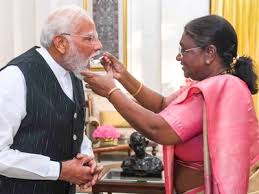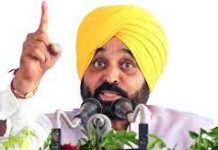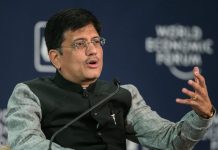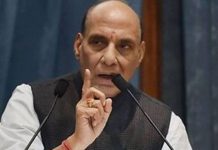Of course, things would unfold with Time and allies would flex their muscles. But as of now, a stable government is in everyone’s interest and that, for good or bad, can only happen with Modi at the helm. By KUMKUM CHADHA

On June 4, a few hours after the election results, Prime Minister Narendra Modi, the erstwhile conqueror, appeared vanquished: somewhat tired of the battle he thought he would not only win but bring home, a crown bigger than ever before.
But that was not to be.
Consequently, when he did make his first public appearance post results at the BJP headquarters, the enthusiasm and the bravado were missing.
The ladoos, presumably in multiples of a hundred kilos, were nowhere in sight. Even the slogans were kind of muted: a far cry from the Modi, Modi chants in the past.
Clearly, the shock was too much for both the audience and the protagonist.
In his speech, Modi tried to reposition the case which, even in victory, was clearly a defeat: BJP had the highest numbers but was short of a majority.
Modi skipped that. Instead, he compared his feat to Jawaharlal Nehru’s: the man he has despised in the past. He told the not so cheering crowds that after Nehru he was the only person to secure a third term.
For record, Nehru was Prime Minister for three successive terms: something Modi claimed to have replicated. What he chose to ignore was that Nehru remained popular till he died.
As against this, Modi’s third term is one where the electorate has delivered a blow. But on that, a little later.
By June 5, Modi seemed to have recovered lost ground, though not entirely.
The NDA meeting of crucial constituents was still a few hours away and the support was neither sealed nor sacrosanct.
On June 5, a Wednesday, Modi wore a bright green jacket.
Astrologically, colors have a special significance. The green colour, worn on a Wednesday, symbolizes growth: much needed for a fractured mandate that the electorate had delivered to the BJP a day earlier.
Whether Modi resorted to astrology is debatable but it is a matter of record that BJP’s Sushma Swaraj religiously followed colour-therapy, coordinating her sarees and even food choices according to the planets. Every Wednesday, the dal cooked in her house would be green. Ditto the sarees she wore.
By the time the swearing in was announced, Modi seemed to have recovered the lost ground. The initial uncertainty of whether he would get a third term was over; his body language had changed and he held sway: at least visibly.
The cracks in the Cabinet formation that were anticipated, did not happen. By the look of it, Modi seemed to have had his way. Allies were accommodated but were unable to extract their pound of flesh. For instance, when the NCP said a Cabinet berth or nothing, Modi gave them nothing.
Modi is known for springing surprises. Therefore, when it came to his Cabinet, one expected him to pull a rabbit out of a hat. Knowing Modi, it would not be one but several.
Modi did surprise everybody when he announced his team: his maintaining a status quo being one such. Quite unexpectedly, Modi preferred continuity over change, retaining most ministers of the outgoing Cabinet.
So, what does this indicate: is Modi being cautious? Or extra careful not to ruffle feathers? Is he presiding over a house of cards which, if a trifle nudged, can collapse? Will he go that extra mile? Or will he have the last word like he did in the past?
That it is a tight rope walk is a given.
One the one hand, there are compulsions of running a coalition; on the other, the challenge of keeping his own house in order. His detractors, both within and outside, are waiting for him to stumble. In this context, RSS chief Mohan Bhagwat’s rap to the Modi government on Manipur, is significant.
Interestingly, Modi and the alliance partners share a common problem: a long-term challenge to keep one’s flock together.
Modi can ill afford any of the allies throwing a tantrum and walking out, if things don’t go their way. He could also face dissent. The way things have panned out, the whip that came handy in the first two terms will perhaps gather rust.
Therefore, despite his demeanor of being in control, Modi is well aware of the problems that may crop up, both within and outside.
As against this, the kingmakers, namely Chandrababu Naidu and Nitish Kumar, too, have to ensure that their MPs remain with them.
BJP’s track record of splitting parties and buying out people either through fear or favour, is well known. Therefore, the allies have to guard against poaching or a straight buy out.
In this context, JD(U) MPs may be more vulnerable, given that their leader Nitish Kumar has often shown the way, earning the paltu-ram nomenclature.
Of course, things would unfold with Time and allies would flex their muscles. But that will be, when it will.
As of now, a stable government is in everyone’s interest and that, for good or bad, can only happen with Modi at the helm.
Equally, the Opposition, when united, did much better than expected but once you decode the numbers, it is a divided house. It is also one which has several claimants for the top job.
Under the circumstances, it was prudent for the INDIA alliance not to throw its hat in the ring.
Rather than try and fail, it made more sense for it to wait and watch: opt to be a strong Opposition than function as a weak government.
As for Modi, despite the divisiveness, one must concede that he is far sighted and decisive.
One could differ with his politics but his governance model has takers. This despite it being interpreted as an agenda which conflicts with the spirit of the Constitution.
Yet, a strong leader versus an amalgam of Opposition parties seems to be the immediate solution for a country that is fast developing.
One cannot take away from Modi his welfare schemes, his women centric agenda, the houses the government built for the poor or the bank accounts it helped open. Nor can one undermine the fact that during his tenure, India stands to be counted on the world stage because when Modi speaks the world listens.
Few would disagree that Modi is the immediate answer to India’s problems: someone who can hold the fort till the country and its political parties throw up a leader to match Modi’s prowess; someone who while steering the country to a path of development can also practice inclusive and constructive politics.
Time is ripe but the leadership is yet to evolve. And till that happens, one will have to contend with Modi and his dahi cheeni, sweetened curd, moment.
Traditionally, one is fed dahi cheeni on auspicious occasions.
For the uninitiated, it was none other than President Droupadi Murmu who fed Modi, the Prime Minister-elect ahead of the swearing in ceremony, dahi cheeni: a move that drew flak on grounds that the President must appear to be non-partisan. It is unbecoming for a constitutional Head of State to display emotion.
As for Modi being fed dahi cheeni, one will have to wait and watch whether History repeats itself. If the recent verdict is any indication, it may not.













